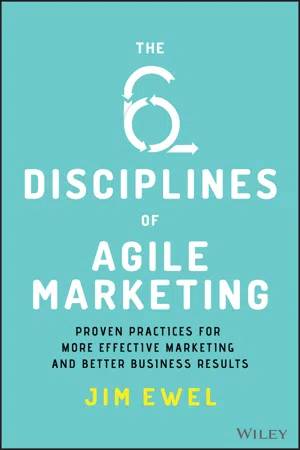
The Six Disciplines of Agile Marketing
Proven Practices for More Effective Marketing and Better Business Results
- English
- ePUB (mobile friendly)
- Available on iOS & Android
The Six Disciplines of Agile Marketing
Proven Practices for More Effective Marketing and Better Business Results
About This Book
Transform your organization using Agile principles with this proven framework
The Six Disciplines of Agile Marketing provides a proven framework for applying Agile principles and processes to marketing. Written by celebrated consultant Jim Ewel, this book provides a concise, approachable, and adaptable strategy for the implementation of Agile in virtually any marketing organization.
The Six Disciplines of Agile Marketing discusses six key areas of practical concern to the marketer who hopes to adopt Agile practices in their organization. They include:
- Aligning the team on common goals
- Structuring the team for greater efficiency
- Implementing processes like Scrum and Kanban in marketing
- Validated Learning
- Adapting to Change
- Creating Remarkable Customer Experiences
The Six Disciplines of Agile Marketing also discusses four shifts in beliefs and behaviors necessary to achieving an Agile transformation in marketing organizations. They include:
- A shift from a focus on outputs to one based on outcomes
- A shift from a campaign mentality to one based on continuous improvement
- A shift from an internal focus to a customer focus
- A shift from top-down decisions to de-centralized decisions
Perfect for anyone in a leadership position at a marketing agency, The Six Disciplines of Agile Marketing also belongs on the bookshelf of anyone interested in improving the efficacy and efficiency of their own marketing efforts. Full of practical advice and concrete strategies that have been successfully implemented at Fortune 500, Silicon Valley, and non-profit organizations alike, this book is an indispensable resource to help your organization make the leap to Agile.
Frequently asked questions
Part I
Overview
Chapter 1
Challenges Facing Marketers Today
You should never view your challenges as a disadvantage. Instead, it's important for you to understand that your experience facing and overcoming adversity is actually one of your biggest advantages.—Michelle Obama, former First Lady of the United States

The Shift to Digital
- Speed. Digital campaigns can be rolled out, changed, and adapted at a speed unimaginable to marketers in channels like television or print. Marketers with the right scale of user interaction can modify campaigns in minutes or hours; almost anyone can achieve a rhythm of weekly change and experimentation. This presents a tremendous opportunity and a challenge. How do we build and manage the marketing processes to take advantage of this speed? How do we organize our teams to move at this speed? What tools do we use?
- Adaptability. If a digital campaign works in one channel (display advertising, say), it's not that difficult to adapt the campaign to work in another channel (Facebook). Compare this to adapting a television campaign to print. Opportunity and challenge: When a prospect sees a message in multiple digital channels, how do we measure the impact of spending in each channel? With each channel having its own ways of grouping audiences, how do we think about audiences holistically, across channels?
- Adjacency. In the physical world, where competitors rarely share a parking lot, consumers tend to value convenience over price. Few drive across town to save a few pennies. On the Internet, your competition is one click away. Opportunity and challenge: It's easier than ever to compete, and, if you're the incumbent, you compete on more than price or you risk the consumer clicking away.
- Scale. If a campaign works for 10,000 digital prospects, then in most channels, given sufficient budget, campaigns can be scaled up overnight for millions of users. But scaling digital campaigns comes with hidden challenges. Often, when we begin a campaign, we focus our message on the most receptive audience possible. Sometimes, we get a very good conversion rate and then, when we scale up the campaign to a more diluted, more representative audience (in terms of receptivity to our product or message), we fail to dup...
Table of contents
- Cover
- Table of Contents
- Foreword
- Preface
- Part I: Overview
- Part II: The Six Disciplines
- Part III: The Four Shifts
- Part IV: Succeeding with Agile Marketing
- Bibliography
- Acknowledgments
- About the Author
- Index
- End User License Agreement